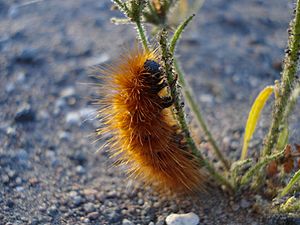Hylesia nigricans facts for kids
Quick facts for kids Hylesia nigricans |
|
|---|---|
 |
|
| Scientific classification | |
| Genus: |
Hylesia
|
| Species: |
nigricans
|
The Hylesia nigricans is a type of moth found in parts of South America. It's also known as the "hairy cat" (gata peluda) or "burning bug" (bicho quemador) in Spanish. This is because its tiny hairs can cause an itchy rash if they touch your skin. This moth is mostly active at night. It belongs to a group of insects called Lepidoptera, which includes butterflies and moths.
Contents
About the Hylesia Moth
The Hylesia nigricans moth is a special kind of moth. It is part of the Saturniidae family, which are often called giant silk moths. This moth lives only in certain areas of South America. You can find it mainly in Argentina, Brazil, and parts of Bolivia. It likes these places because the weather helps it to grow and have babies. A scientist named Carlos Berg first described this moth in 1875.
What the Moth Looks Like
The adult female moth can have wings that spread about 45 millimeters wide. That's about the length of a golf tee! The adult moths are dark in color. This is where their name comes from, as "nigricans" means "blackish." The back part of their body is covered with smooth, golden hairs.
The young moths, called larvae or caterpillars, are about 40 to 45 millimeters long. They have black and yellow bodies. These caterpillars are covered with tiny, stinging hairs. If these hairs touch your skin, they can cause an itchy rash. This rash is called dermatitis.
What the Moth Eats
The Hylesia nigricans caterpillar loves to eat! It has a very big appetite. It can eat many types of plants, including fruit trees, garden plants, and forest trees. Because it eats so much, it was even declared a "national plague" in Argentina in 1911. This means it caused a lot of damage to plants across the country.
Life Cycle
The Hylesia nigricans moth goes through several stages in its life. This is called its life cycle.
Eggs and Hatching
The female moth lays her eggs in layers. She can lay up to 900 eggs at once! She protects these eggs by covering them with a yellow cocoon. She builds this cocoon using special liquids from her body and hairs from her belly. In the spring, usually from October to December, many of these eggs hatch. About 200 to 740 tiny caterpillars can come out from one batch of eggs.
Caterpillar Stage
Once the caterpillars hatch, they move around in big groups. They crawl along tree trunks, branches, and leaves. Because there are so many of them, they often eat almost all the leaves on a tree. This is called defoliation.
Pupation and Winter Rest
Before the caterpillar turns into an adult moth, it changes into a pupa. This is like a resting stage. The caterpillar gathers leaves and sticks them together with a special liquid from its body. It uses these leaves to make a cocoon. The cocoon can be on a plant or among the leaves on the ground. The pupa stays still inside its cocoon during the cold winter months. It waits there until it is ready to become an adult moth.
See also
 In Spanish: Hylesia nigricans para niños
In Spanish: Hylesia nigricans para niños

